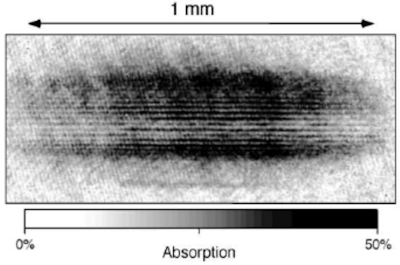![]() On July 27th, NASA announced that researchers have created Bose-Einstein Condensates (BECs) onboard the International Space Station.
On July 27th, NASA announced that researchers have created Bose-Einstein Condensates (BECs) onboard the International Space Station.
From Spaceweather.com:
These “super atoms” don’t behave like particles of normal matter. They’re more like matter waves, obeying the strange laws of quantum mechanics. Unlike other objects from the Quantum Realm, however, BECs are large enough to see with the unaided eye:

How weird are BECs? Consider the following: If you create two BECs and put them together, they don’t mix like an ordinary gas. Instead, they can “interfere” like waves: thin, parallel layers of matter are separated by thin layers of empty space. An atom in one BEC can add itself to an atom in another BEC and produce – no atom at all.
First predicted by Indian physicist Satyendra Nath Bose and Albert Einstein in the 1920s, BECs are hard to study on Earth because the pull of gravity rips them apart in a fraction of a second. In the microgravity environment of the space station, however, BECs can hold their form for 5 to 10 seconds.
Researchers have been making BECs inside the space station’s Cold Atom Lab, an atomic refrigerator that can cool rubidium vapors down to one ten-millionth of a degree above absolute zero. Each BEC is assembled from a few million rubidium atoms.
Bose-Einstein condensates are quantum creatures big enough to see–and therein lies their promise. Many cutting-edge technologies such as smaller, faster computer chips, micro-electro-mechanical systems (MEMS) and quantum computers lie in the twilight zone between the quantum world and the macroscopic world. Scientists hope that studying BECs will advance those technologies and create others.








